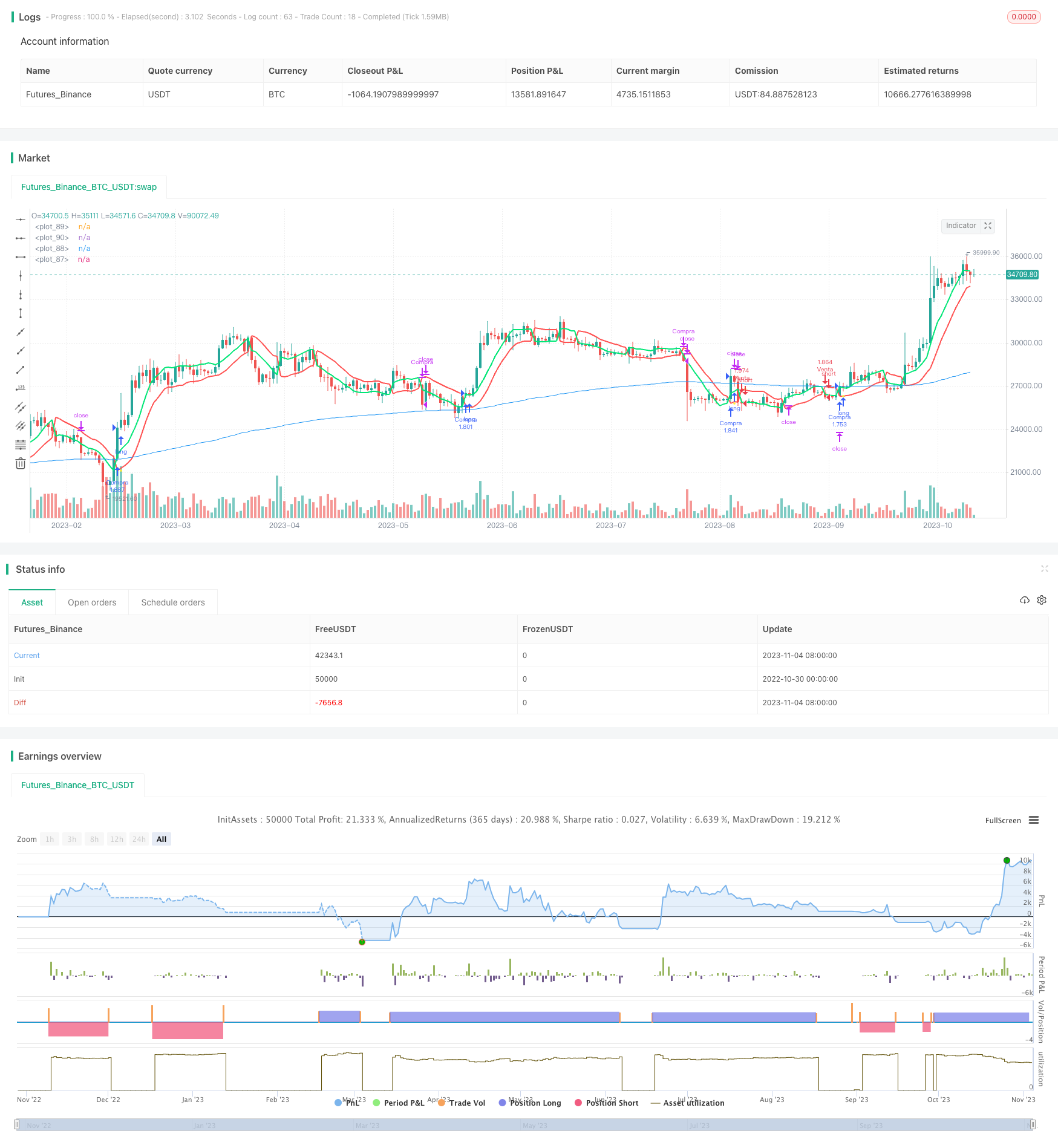
概述
该策略融合了双顺势指标和移动均线指标,运用双顺势指标来判断市场趋势方向,以及利用移动均线进行趋势确认,属于趋势跟踪策略。结合止损来控制风险,属于较为稳定的策略。
策略原理
计算昨日收盘价与指定周期内最高价的SMA均值构成的上轨,以及昨日收盘价与指定周期内最低价的SMA均值构成的下轨。
比较当前收盘价与上轨、下轨的关系,判断目前趋势方向。收盘价高于上轨,判断为多头;收盘价低于下轨,判断为空头。
计算200周期的收盘价SMA均线,作为中长线趋势的判断标准。
当判断为多头时,如果收盘价由下方向上突破SMA均线,产生买入信号;当判断为空头时,如果收盘价由上方向下突破SMA均线,产生卖出信号。
进入多头仓位后,若收盘价下破上轨,作为平仓信号;进入空头仓位后,若收盘价上破下轨,作为平仓信号。
设置固定比例的止损点,如收盘价下破止损点,则激活止损单。
策略优势
使用双顺势指标判断趋势方向,可有效识别趋势,增强进入正确方向的概率。
均线的加入,可过滤掉部分噪音信号,避免在震荡行情中错交易。
采用止损来控制单笔损失风险,可以有效避免亏损过大。
策略操作相对简单,容易理解实现,适合初学者练手。
策略风险
双顺势指标对参数设置较为敏感,不同周期参数组合,会导致结果差异较大,需谨慎测试参数的优化。
均线设置过长,会过滤掉较多交易机会;均线过短,则对去噪效果不佳。需权衡均线周期参数的设置。
止损点设置过宽,无法起到很好的风险控制;过窄则容易被价格常规波动触发退出。需谨慎设定止损范围。
策略较依赖参数优化,如果参数设置不当,则可能无法正确识别趋势方向,导致交易决策失误。
策略优化方向
可以测试不同周期参数的组合,寻找使双顺势指标对趋势判断更准确的参数。
可以测试不同周期的均线指标,找到平衡去噪效果和保留信号的最佳均线参数。
可以尝试根据市场波动程度,设计自适应调整的止损机制,使止损更贴近市场情况。
还可以尝试加入其他指标进行辅助,如量价确认、多时间框架畅通等,来提升策略的稳定性。
优化后的策略,可以使用walk forward分析进行验证,以确保参数仍具有稳健性。
总结
该策略整合双顺势指标和移动均线的优势,属于参数优化余地较大的趋势跟踪策略。通过合理的参数设定及优化,可以获得较好的策略表现。但需注意控制参数过度优化的风险,保证参数稳健性。整体来说,该策略适合用作策略探索和学习的案例。
/*backtest
start: 2022-10-30 00:00:00
end: 2023-11-05 00:00:00
period: 1d
basePeriod: 1h
exchanges: [{"eid":"Futures_Binance","currency":"BTC_USDT"}]
*/
//@version=5
//@Isaac
//Estrategia vista en ▼▼
//YT: Trading Zone
strategy('SSL Strategy + EMA 200 AND Stop Loss', overlay=true)
ema = ta.ema(close, 200)
stop_loss = input.float(2.00, title='Stop Loss', step=0.10)
period = input(title='Period', defval=10)
len = input(title='Period', defval=10)
smaHigh = ta.sma(high, len)
smaLow = ta.sma(low, len)
Hlv = int(na)
Hlv := close > smaHigh ? 1 : close < smaLow ? -1 : Hlv[1]
sslDown = Hlv < 0 ? smaHigh : smaLow
sslUp = Hlv < 0 ? smaLow : smaHigh
cruceArriba = ta.crossover(sslUp, sslDown)
cruceAbajo = ta.crossunder(sslUp, sslDown)
alcista = (close > ema ) and (cruceArriba)
bajista = (close < ema) and (cruceAbajo)
var SL = 0.0
//Cerrar compra por cruce
por_cruce = ta.crossunder(sslUp, sslDown)
//Cerrar venta por cruce
por_cruceAB = ta.crossunder(sslDown, sslUp)
//Cerrar compra y venta por stop loss
Stop = SL
comprado = strategy.position_size > 0
vendido = strategy.position_size < 0
UTmpconvertL = strategy.position_avg_price * (1 + 0.1)
UTmpdefineL = (UTmpconvertL > close and strategy.openprofit > 0.1)
UTSPL = UTmpdefineL
SPL = UTSPL
///////////////////////////////////////////////////////////////////////
UTmpconvertLS = strategy.position_avg_price * (1 + 0.1)
UTmpdefineLS = (UTmpconvertLS > close and strategy.openprofit > 0.1)
UTSPLS = UTmpdefineLS
SPLS = UTSPLS
////////////////////////////////////////////////////////////////////////
if not comprado and not vendido and alcista
cantidad = (strategy.equity / close)
strategy.entry('Compra', strategy.long, qty=cantidad, comment="Long")
SL := sslDown
if comprado and not vendido and por_cruce and SPL
strategy.close("Compra", comment="Exit Long")
SL := 0
if comprado and not vendido and Stop
strategy.exit('Compra', stop=Stop, comment="SL")
SL := 0
///////////////////////////////////////////////////////////////////
if not comprado and not vendido and bajista
cantidad = (strategy.equity / close)
strategy.entry('Venta', strategy.short, qty=cantidad, comment="Short")
SL := sslDown
if not comprado and vendido and por_cruceAB and SPLS
strategy.close("Venta", comment="Exit Short")
SL := 0
if not comprado and vendido and Stop
strategy.exit('Venta', stop=Stop, comment="SLS")
SL := 0
plot(Stop > 0 ? Stop : na, style=plot.style_circles, color=color.new(color.yellow,0))
plot(ema)
plot(sslDown, linewidth=2, color=color.new(color.red, 0))
plot(sslUp, linewidth=2, color=color.new(color.lime, 0))